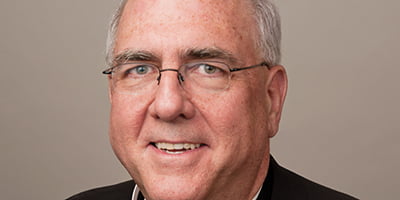by Archbishop Joseph F. Naumann
Last week, I wrote about the reasons for m annual pilgrimage with our seminarians, encouraging everyone to pray for and promote priestly vocations for the archdiocese. The next two weeks, I want to share with you some of the highlights for me and some of the insights gained from this year’s pilgrimage.
In Santa Fe, we visited the famous Loretto Staircase. Archbishop Jean-Baptiste Lamy, the first archbishop of Santa Fe, New Mexico, invited the Sisters of Loretto to establish a school there for young women. A beautiful chapel was built for the school with one small defect. There was no way to access the choir loft except by ladder. The Sisters had inquired about building a staircase, but every design required taking up too much space in the small chapel.
The Sisters made a novena to St. Joseph asking him to help them find a solution to their problem. On the last day of the novena, a humbly dressed man seeking work showed up at their door. The Sisters believed him to be an answer to their prayers. They asked him to build the staircase. He agreed with the condition that he would be allowed to work alone.
He built a magnificent spiral staircase that still baffles architects and engineers. The stairway was constructed without nails and lacks any internal support. It is perfectly balanced. Father Scott Wallisch, our vocation director, who has a degree
in architectural engineering, was fascinated by the stairway.
Our guide cautioned us that there are claims on the Internet that purport to know the identity of the man who built the stairs. Our docent claimed that the man identified did indeed build a staircase for the Sisters, but it was in their academic building, not in the chapel.
Moreover, they have the correspondence between the mother superior in Kentucky and local superior in Santa Fe. In Kentucky, they had received reports about this miraculous staircase at the convent in New Mexico.
The mother superior specifically asked for the name of the builder of the stairs. The Santa Fe local superior simply replied they did not know the identity of the mysterious carpenter.
The staircase builder left without receiving compensation. The Sisters had not even paid for the materials. They inquired with the local lumberyard owner to reimburse him for the wood, only to learn that he had not supplied any materials for the project. Our guide informed us that scientists have examined the wood and found it to be a unique composition. The wood to which it is most similar is not indigenous to New Mexico.
The Sisters had not kept up with the capital repair needs for the school or the chapel. Consequently, the Sisters sold the academy with its chapel in the late 1960s to a developer who wanted to build a hotel at that location. He intended to tear down the chapel, until his wife intervened requesting that he preserve it. The chapel is currently owned by a private foundation, not the Catholic Church.
The foundation rents the chapel for weddings and other religious events. Visitors to the chapel are not permitted to walk on the staircase. Couples, who rent the chapel for their wedding, are allowed to have a photo taken of them standing on the stairs.
I had actually left the chapel, when one of our seminarians urged me to return, because the guide had told him that visiting bishops were given the privilege of ascending the steps. I was delighted to take advantage of the opportunity. I gave
our seminarians and the other visitors a blessing and invoked St. Joseph’s intercession for all the pilgrims. I can attest to the strength and quality of the stairway as it withstood my weight!
The Loretto Staircase is popularly viewed as an unsolved mystery, but it has not been given the status of an authenticated miracle by the church. Still, it is a place of great devotion, where many pilgrims come to find inspiration.
My mother has great devotion to St. Joseph. When I informed her that I was allowed to walk on the stairs believed to be built by St. Joseph or his delegate, she was elated. I think she was more impressed that I was able to walk on the Loretto Stairs than about me being named a bishop.
My mother is not the only one with special devotion to St. Joseph. The first liturgical change authorized personally by Pope Francis was to include St. Joseph in each of the eucharistic prayers.
St. Joseph is my patron saint. I have found him to be a great friend and intercessor with whom to approach Jesus regarding the many challenges of my ministry as bishop. He is especially
a great patron for men and particularly fathers.
St. Joseph is most popularly venerated for assistance with selling houses. He is also one that many pray to for a serene and happy death for themselves and loved ones, because, according to tradition, he died in the company of Jesus and Mary.
Whatever your circumstance, I encourage you, like the Santa Fe Loretto Sisters more than a century ago, to entrust your special needs and intentions to St. Joseph.
St. Joseph, pray for us!



